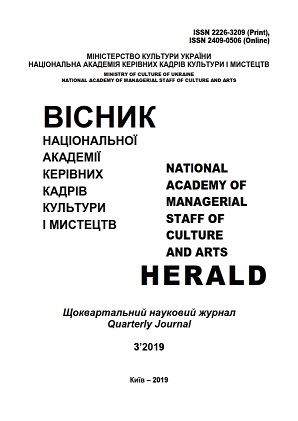Symbolic Transformation of the Widow`s Image in Biblical Cultural Tradition: Semantics, Analogies, Universal Features
Symbolic Transformation of the Widow`s Image in Biblical Cultural Tradition: Semantics, Analogies, Universal Features
Author(s): Oleh Mikhaylovich Shepetyak, Svitlana Anatoliyivna KhrypkoSubject(s): Cultural history, Customs / Folklore, Semiology, Social Philosophy, Gender history, Semantics, Culture and social structure , Biblical studies, Hermeneutics
Published by: Національна академія керівних кадрів культури і мистецтв
Keywords: widow; cultured tradition; value; history of an image; axiology; orphan; symbolic; semantic; solitude; exclusivity; protection; separation; intercession;
Summary/Abstract: The purpose of the work is to analyze the specific features of a widow‘s image and status on the Bible pages, to consider semantic contexts of an image, to follow the parallels between the images of an orphan and a widow, to conceive a loneliness phenomenon and orphans‘ and widows‘ protection in Biblical tradition. Axiological variety and poly vector spiritual and semantic representation of Biblical women‘ images are the main focuses of the issue. Methodologically the issue is based on the original source of the Bible. The work is based on methodical description of the women‘ images, who are selected from the Old and New Testament in order to highlight valued features of each image. Moreover, the methods of semantic analysis and hermeneutics are applied to consider semantic differences. The principles of comparative analysis are applied in order to reveal the traits of a widow‘s image in the blocks of historical texts and compare Ukrainian context of widows‘ existence with biblical one. Scientific novelty is in the poly semantic analysis of the women‘ Biblical context and widows‘ images separation with further analysis of their fates, valued statuses, which allowed them to embody the problems of motherhood and marriage, future children birth and solitude, the problem of divine protection in different ways. The issue is devoted to the consideration of symbolic and axiological poly vector transformations of the mentioned problems. Conclusions. The social polarity and spiritual separation of a widow‘s place and role in ancient tradition, and poly vector semantics of a widow‘s Biblical context are conceived. The attention is drawn to the varied contexts of solitude, selectiveness, devoted life, vocation, divine protection of a widow. A widow‘s image is compared with orphans‘ statuses, levits, foreigners, etc. A widow‘s figure is shown as a symbolic one. The ideas of selectiveness, God blessing, obedience, and humility, a miracle of sacred and virgin life are embodied in a person, whose name is translated as ―tears of sea‖. Virgin Mary is a crown of a widow‘s image understanding in Biblical tradition.
Journal: Вісник Національної академії керівних кадрів культури і мистецтв
- Issue Year: 2019
- Issue No: 3
- Page Range: 67-72
- Page Count: 6
- Language: English

